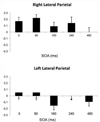Self-enhancement processing in the default network: a single-pulse TMS study
- PMID: 22965551
- PMCID: PMC4055952
- DOI: 10.1007/s00221-012-3249-7
Self-enhancement processing in the default network: a single-pulse TMS study
Abstract
Much research has been done on positive self-evaluation and its relationship to mental health. However, little is known about its neural underpinnings. Imaging studies have suggested that the brain's default network is involved with self-related processing and that one portion of the default network, medial prefrontal cortex (MPFC), is particularly involved with self-evaluation. Here, we used transcranial magnetic stimulation (TMS) to causally demonstrate that this network, and particularly MPFC, is involved with self-evaluative processing. In a first experiment, 27 healthy volunteers judged whether adjectives, evenly divided between desirable and undesirable traits, described themselves or their best friends, and a robust self-enhancement bias effect was found. In a second experiment, single-pulse TMS was applied targeting three locations (MPFC and left and right parietal cortex) in a different group of healthy volunteers while they performed the adjective task. In each trial, TMS was applied at one of five different times relative to onset of the adjective ranging from 0 to 480 ms. TMS affected self-enhancement bias in a site- and latency-specific manner: at MPFC, the self-enhancement bias actually reversed at 160 ms, with subjects favoring their best friend over themselves. TMS may thus be of use in investigating areas of mental illness in which self-evaluation is abnormal, potentially as a diagnostic tool. In addition, the present study, combined with our previous reports (Lou et al., Proc Natl Acad Sci USA 101(17):6827-6832, 2004, Exp Brain Res 207:27-38, 2010), causally demonstrates two kinds of self-related processing within the default network, one centered in parietal cortex and concerned with retrieval of self-related associations, and the other MPFC-centered and involved in self-evaluative processing.
Figures





Similar articles
-
Self-specific processing in the default network: a single-pulse TMS study.Exp Brain Res. 2010 Nov;207(1-2):27-38. doi: 10.1007/s00221-010-2425-x. Epub 2010 Sep 29. Exp Brain Res. 2010. PMID: 20878395 Free PMC article.
-
Assessing the neural correlates of self-enhancement bias: a transcranial magnetic stimulation study.Exp Brain Res. 2007 Sep;182(3):379-85. doi: 10.1007/s00221-007-0992-2. Epub 2007 Jul 3. Exp Brain Res. 2007. PMID: 17607566
-
The role of medial prefrontal cortex in processing emotional self-referential information: a combined TMS/fMRI study.Brain Imaging Behav. 2019 Jun;13(3):603-614. doi: 10.1007/s11682-018-9867-3. Brain Imaging Behav. 2019. PMID: 29744797
-
Transcranial magnetic stimulation of medial prefrontal cortex modulates implicit attitudes towards food.Appetite. 2015 Jun;89:70-6. doi: 10.1016/j.appet.2015.01.014. Epub 2015 Jan 22. Appetite. 2015. PMID: 25620531 Review.
-
Enhancement of human cognitive performance using transcranial magnetic stimulation (TMS).Neuroimage. 2014 Jan 15;85 Pt 3(0 3):961-70. doi: 10.1016/j.neuroimage.2013.06.007. Epub 2013 Jun 13. Neuroimage. 2014. PMID: 23770409 Free PMC article. Review.
Cited by
-
Common hyper-entropy patterns identified in nicotine smoking, marijuana use, and alcohol use based on uni-drug dependence cohorts.Med Biol Eng Comput. 2023 Dec;61(12):3159-3166. doi: 10.1007/s11517-023-02932-w. Epub 2023 Sep 18. Med Biol Eng Comput. 2023. PMID: 37718388 Free PMC article.
-
Transcranial Direct Current Stimulation of the Medial Prefrontal Cortex Has No Specific Effect on Self-referential Processes.Front Hum Neurosci. 2020 Mar 11;14:56. doi: 10.3389/fnhum.2020.00056. eCollection 2020. Front Hum Neurosci. 2020. PMID: 32218726 Free PMC article.
-
The self and conscious experience.Front Psychol. 2024 Jan 25;15:1340943. doi: 10.3389/fpsyg.2024.1340943. eCollection 2024. Front Psychol. 2024. PMID: 38333065 Free PMC article. Review.
-
Brain Networks, Neurotransmitters and Psychedelics: Towards a Neurochemistry of Self-Awareness.Curr Neurol Neurosci Rep. 2024 Aug;24(8):323-340. doi: 10.1007/s11910-024-01353-y. Epub 2024 Jul 9. Curr Neurol Neurosci Rep. 2024. PMID: 38980658 Free PMC article. Review.
-
Mindfulness-induced selflessness: a MEG neurophenomenological study.Front Hum Neurosci. 2013 Sep 24;7:582. doi: 10.3389/fnhum.2013.00582. eCollection 2013. Front Hum Neurosci. 2013. PMID: 24068990 Free PMC article.
References
-
- Alloy LB, Abramson LY. Depressive realism: Four theoretical perspectives. In: Alloy LB, editor. Cognitive processes in depression. New York: Guilford Press; 1988. pp. 223–265.
-
- Amassian VE, Cracco RQ, Maccabee PJ, Cracco JB, Rudell A, Eberle L. Suppression of visual perception by magnetic coil stimulation of human occipital cortex. Electroenceph Clin Neurophysiol. 1989;74:458–462. - PubMed
-
- Anderson N. Likeableness ratings of 555 personality-trait adjectives. J Personality Soc Psychol. 1968;9(3):272–279. - PubMed
-
- Andreasen NC, O'Leary DS, Cizadlo T, Arndt S, Rezai K, Watkins GL, Boles Ponto LL, Hichwa RD. Remembering the past: Two facets of episodic memory explored with positron emission tomography. Amer J Psychiatry. 1995;152:1576–1585. - PubMed
-
- Barrios V, Kwan VSY, Ganis G, Gorman J, Romanowski J, Keenan JP. Elucidating the neural correlates of egoistic and moralistic self-enhancement. Consciousness and Cogn. 2008;17:451–456. - PubMed
Publication types
MeSH terms
Grants and funding
LinkOut - more resources
Full Text Sources
Other Literature Sources

